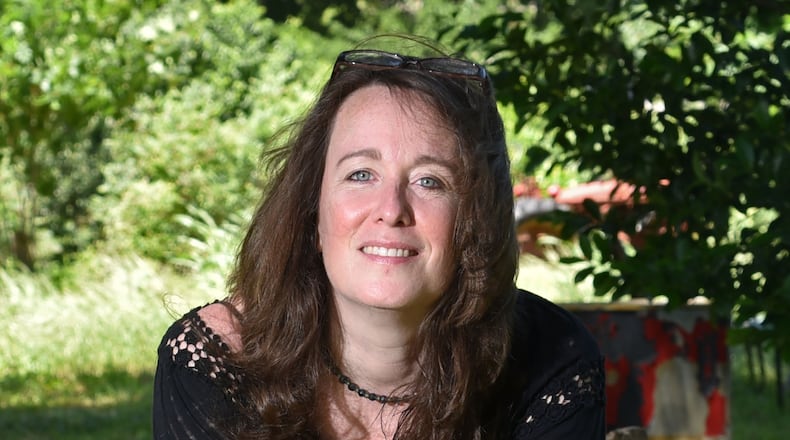Whether you read them to yourself when you were a child, or you read them aloud to your own children, everyone who has encountered the Choose Your Own Adventure book series popular in the ‘80s and ‘90s adores them.
Broadly classified as a gamebook, the series casts the reader in the role of the story’s protagonist who has to make a series of choices as the narrative unfolds. One of the pleasures of the book is the alternate endings and seeing the different ways the narrative changes based on the reader’s decisions.
Among the format’s biggest fans is Atlanta author Laurel Snyder, 48, whose new, rhyming picture book “Endlessly Ever After” (Chronicle Books, $18.99), illustrated by Dan Santat, was inspired by the concept.
After her fifth-grade teacher read “The Mystery of Chimney Rock” in class one day, Snyder went to the library and devoured every book she could find in the series.
“I was always interested, not just in the stories themselves, but in the way they were put together,” she said. “I remember flipping back and forth and trying to reverse engineer so that I could figure out how to get to the best paths before I’d read the whole book.”
So taken was she by the idea, that it shaped a poignant project she produced in graduate school at the Iowa Writers Workshop. She made a chapbook that told the story of her divorced parents’ courtship through a series of poems told from her father’s point of view, her mother’s point of view and a third-person POV woven together in a “pick-your-path” format.
“You could read the book through my dad’s eyes or you could read the book through my mom’s eyes or you could go back and forth and see other people’s perspectives,” Snyder recalled.
Credit: Chronicle Books
Credit: Chronicle Books
Snyder is now a successful and prolific author of picture books and chapter books for middle-grade readers, including “Swan: The Life and Death of Anna Pavlova,” “Charlie & Mouse,” “Orphan Island” and “My Jasper June.”
Eight years ago, she began work on her 2019 picture book “Hungry Jim” about a boy who wakes up one morning and discovers he’s turned into a lion. She originally wrote the book in the pick-your-path format. Although her editor loved the story and the format, she didn’t think the two made a good fit. Snyder revised the book and it was eventually published as a linear narrative.
But Snyder wasn’t ready to give up on the idea, so she set out to figure out what kind of story would be a good fit for the format. That’s when she hit upon fairytales.
“The nice thing about fairytales is that kids come with preconceived notions,” she said, which makes it easy to subvert the narrative. “Like, what if Little Red Riding Hood doesn’t have to be Little Red Riding Hood? What if she wants to wear something else that day? … If Little Red Riding Hood can go any direction, can wander into somebody else’s stories, what would that look like? That’s where I started.”
Strikingly illustrated in a moody palette of greens and golds and rust, “Endlessly Ever After” is a delightful tale of a plucky protagonist who finds herself, depending on the reader’s selections, in one of six classic fairytales, including “Little Red Riding Hood,” “Sleeping Beauty,” “Snow White,” “Jack and the Beanstalk,” “Hansel and Gretel” and “The Three Little Pigs.”
“It’s a collection of six sets of characters, but depending on what direction you go,” said Snyder, “some of those stories go in multiple directions and there are several endings.”
Although the tone is playful and humorous and the stories are filled with thrilling adventure, there is a shadow of darkness appropriate to the material. On more than one occasion, the protagonist meets her demise at the end.
“That’s part of the beauty of it,” said Snyder. “Because you’re going to read it again and again and again. If you know you get a do-over, it’s like reincarnation almost. She gets to come back again and again, as many times as you want her to, so the deaths don’t land the same. It’s like a cartoon. … In the Roadrunner, the Coyote is always going to get flattened, but he comes and comes back.”
Addressing themes of death and dying is nothing new for Snyder. Her 2013 book “The Longest Night: A Passover Story” details the Bible’s 10 plagues. “Swan” ends with the death of Anna Pavlova.
“It’s always been critically important to me that we recognize that on some level, and books are the best way to encounter these scary ideas because they’re safe, because you can close them,” she said. “Especially with picture books, which you’re so often reading to children. You’re there holding them.”
Although “Endlessly Ever After” has multiple endings, Snyder said there is one ending she considers to be the ending.
“If you get to this point, you understand the purpose of the whole book,” she said.
“There are two sets of messages people get,” said Snyder. “One set of messages is, follow the rules, and one set of messages is, follow your heart. We all live in a world that has all of those messages all the time. But it’s not as simple as, if you just follow the rules everything will be fine. Or, (forget) the rules, do what you want. Because the truth is, we live in a world where we affect other people and there are ripple effects to everything we do.
“For me the message of the book is that there’s this path for you and you’re going to sometimes stay on it and you’re going to sometimes stray. Sometimes you might be curious and wander off the path, sometimes it’s going to feel like you made a mistake. Sometimes you’re going to want to come back to the path. What really matters is thoughtfulness and mindfulness.”
Suzanne Van Atten is a book critic and contributing editor to The Atlanta Journal Constitution. Contact her at svanatten@ajc.com and follow her on Twitter at @svanatten.
About the Author
The Latest
Featured



